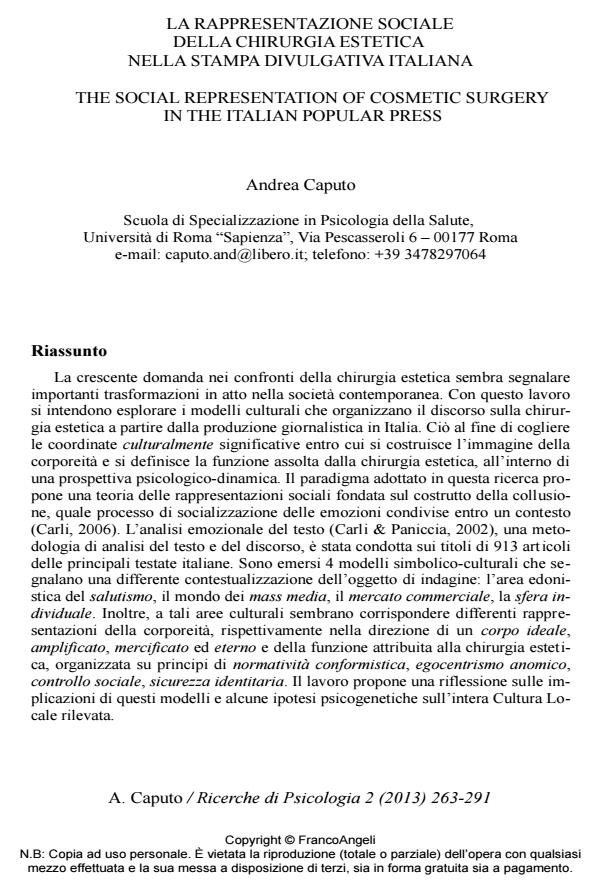The social representation of cosmetic surgery in the italian popular press
Journal title RICERCHE DI PSICOLOGIA
Author/s Andrea Caputo
Publishing Year 2013 Issue 2013/2
Language Italian Pages 29 P. 263-291 File size 364 KB
DOI 10.3280/RIP2013-002003
DOI is like a bar code for intellectual property: to have more infomation
click here
Below, you can see the article first page
If you want to buy this article in PDF format, you can do it, following the instructions to buy download credits

FrancoAngeli is member of Publishers International Linking Association, Inc (PILA), a not-for-profit association which run the CrossRef service enabling links to and from online scholarly content.
The increasing demand for cosmetic surgery seems to indicate important changes taking place in contemporary society. This work aims at exploring the cultural models that organize the discourse on cosmetic surgery from the journalistic production in Italy. This is to capture the culturally significant coordinates within which the body image is shaped and the role played by cosmetic surgery is defined, in a psycho-dynamic perspective. The paradigm adopted in this study proposes a social representations theory based on the construct of collusion, as process of socialization of emotions that are shared within a context (Carli, 2006). The emotional text analysis (Carli e Paniccia, 2002), a methodology of textual and discourse analysis, has been conducted on the titles of 913 articles of the main Italian newspapers. Four symbolic models have emerged that indicate a different cultural contextualization of the object of investigation: the hedonistic area of health fanaticism, the world of mass media, the commercial market, the individual sphere. Moreover, these areas seem to be connected with different cultural representations of the body image, respectively, in the direction of an ideal, amplified, commodified and eternal body and of the function attributed to cosmetic surgery, organized on principles of conformist normativity, anomic selfcenteredness, social control, identity self-assurance. This work offers a reflection on the implications of these models and psychogenetic hypotheses on the entire Local Culture detected.
Keywords: Cosmetic surgery, social representations, cultural models, emotional text analysis, collusion.
- Self-awareness and Social Influences as Predictors of Body Dissatisfaction and Acceptance of Cosmetic Surgery for Social Reasons Among Men Amanda Nerini, Cristian Di Gesto, Martina Lo Bartolo, Alessandro Innocenti, Cristina Stefanile, Camilla Matera, in Aesthetic Plastic Surgery /2024 pp.1016
DOI: 10.1007/s00266-023-03565-y - The factor structure and psychometric properties of the Italian version of the Acceptance of Cosmetic Surgery Scale Cristina Stefanile, Amanda Nerini, Camilla Matera, in Body Image /2014 pp.370
DOI: 10.1016/j.bodyim.2014.06.005 - Changing to Impress: Testing a Mediation Model from Instagram Self-presentation to Cosmetic Surgery Tommaso Galeotti, Claudia Marino, Natale Canale, Luca Scacchi, Alessio Vieno, in Aesthetic Plastic Surgery /2024 pp.764
DOI: 10.1007/s00266-023-03501-0
Andrea Caputo, La rappresentazione sociale della chirurgia estetica nella stampa divulgativa italiana in "RICERCHE DI PSICOLOGIA " 2/2013, pp 263-291, DOI: 10.3280/RIP2013-002003